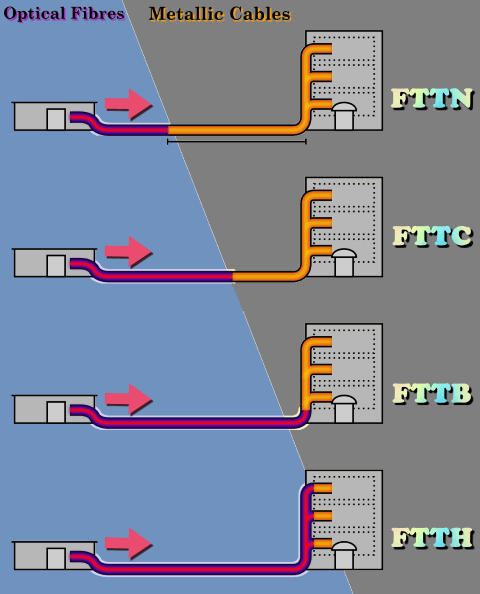
FTTN, FTTC, FFTB and FTTH are acronyms for fiber connections. A fiber optic cable is nothing more than a set of very thin transparent filaments of glass fiber or plastic polymers, approximately the width of a human hair, held together by a protective rubber sheath. The characteristics that distinguish this type of cable from the regular copper cables, the so-called “twisted pair”, are that of being able to carry much more data / information per unit of time and, at the same time, being lighter and easier to handle, more flexible, substantially immune to electrical noise and more resistant to external atmospheric conditions (for example, they are less affected by temperature variations and less likely to break in strong winds because of their greater flexibility). All these features make the fiber cables more performant in terms of transmission capacity and less prone to failure and inconveniences, thus greatly reducing the disservices to customers as well as maintenance costs. In the image below you can get an idea of the various acronyms used for the types of fiber connections provided by ISPs (Internet Service Providers).

FTTN
Fiber to the Node or Neighborhood serves a few hundred customers. Said customers must be within a one mile radius. The remaining distance to the home, often referred to as the “last mile,” can use DSL through existing telephone or cable company lines. Customer proximity to the node and delivery protocols determine data rates.
FTTC
Fiber to the Curb doesn’t refer to an actual curb. It’s the pole or closet that houses the mounted communications device. Coaxial cables or twisted pairs then send the signals from the curb to the home. However, bandwidth is lost during this delivery. FTTC can serve several customers within 1,000 feet.
FTTB
Fiber to the Building, Business, or Basement. Fiber reaches the boundary of the building, such as the basement in a multi-dwelling unit, with the final connection to the individual living space being made via alternative means, similar to the curb or pole technologies.
FTTH
Fiber to the Home moves between the property line switch box and the residents’ junction boxes. Because the connection goes directly to individual residences, FTTH offers a higher bandwidth. It’s expensive to install in some countries or regions of a country, but it’s gaining popularity. Countries like Romania have one of the highest FTTH coverages in the world (leading FTTH provider in Romania: DIGI Romania). Some carriers install fiber optics for this leg as a selling feature in new residential areas.
Note: When you have a Synology NAS and want to access it from the outside, it’s a good idea to have a FTTH fiber connection. Another great advantage is that many ISPs can also provide a static IP address which is ideal if you have a Synology NAS. Fast-forward a decade and fiber connections will be the norm worldwide.
Note: While FTTH can offer faster speeds, it is currently more expensive to install (however, some ISPs offer free installation with new contracts). FTTC, FTTB or FTTN provide fiber optic Internet to more customers at lower costs.
Note: The closer the fiber optic legs to the final destination, the better the connection. FTTH offers a better bandwidth connection.
This post was updated on Saturday / August 27th, 2022 at 4:29 PM
